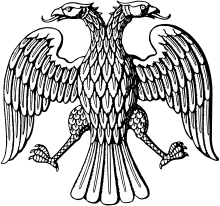Russian Republic
The Russian Republic,[lower-alpha 1] was a short-lived state which controlled, de jure, the territory of the former Russian Empire after its proclamation by the Russian Provisional Government on 1 September (14 September, N.S.) 1917 in a decree signed by Alexander Kerensky as Minister-Chairman and Alexander Zarudny as Minister of Justice.[1]
Russian Republic (1917) Российская Республика | |||||||||||||||||||||||||||
|---|---|---|---|---|---|---|---|---|---|---|---|---|---|---|---|---|---|---|---|---|---|---|---|---|---|---|---|
| 1917 | |||||||||||||||||||||||||||
Proclaimed territory of the Russian Republic | |||||||||||||||||||||||||||
| Capital | Petrograd | ||||||||||||||||||||||||||
| Common languages | Russian | ||||||||||||||||||||||||||
| Government | Provisional government | ||||||||||||||||||||||||||
| Minister-Chairman | |||||||||||||||||||||||||||
• Mar-Jul 1917 | Georgy Lvov | ||||||||||||||||||||||||||
• Jul-Nov 1917 | Alexander Kerensky | ||||||||||||||||||||||||||
| Legislature | Provisional Council (1917) | ||||||||||||||||||||||||||
| Historical era | World War I | ||||||||||||||||||||||||||
| 8–16 March 1917 | |||||||||||||||||||||||||||
• Republic proclaimed | 14 September 1917 | ||||||||||||||||||||||||||
| 7 November 1917 | |||||||||||||||||||||||||||
| Currency | Ruble | ||||||||||||||||||||||||||
| |||||||||||||||||||||||||||
Part of a series on the |
||||||||||||||||||||||||||
|---|---|---|---|---|---|---|---|---|---|---|---|---|---|---|---|---|---|---|---|---|---|---|---|---|---|---|
| History of Russia | ||||||||||||||||||||||||||
 | ||||||||||||||||||||||||||
|
||||||||||||||||||||||||||
| Timeline | ||||||||||||||||||||||||||
|
| ||||||||||||||||||||||||||
After the seizure of power, the Bolsheviks used the name "Russian Republic" for some time, until the name "RSFSR" was officially adopted. In 1918, an unsuccessful attempt was made to revive the Russian Republic under the name "Russian Democratic Federative Republic". This decision was made by the All-Russian Constituent Assembly, but this decision was not executed, because the Assembly was instantly dissolved and the territory was controlled by the Bolsheviks who proclaimed the RSFSR.
The term "Russian Republic" is sometimes used erroneously for the period between the abdication of the Emperor Nicholas II on 3 March 1917 (16 March, N.S) and the declaration of the Republic in September. However, during that period the future status of the monarchy remained unresolved.
Politics
Officially, the Republic's government was the Provisional Government, although de facto control of the country was contested between it, the soviets (chiefly the Petrograd Soviet), and various ethnic-based separatists (such as the Central Council of Ukraine). Soviets were political organizations of the proletariat, strongest in industrial regions, and were dominated by left-wing parties. Soviets, whose influence was supplemented with paramilitary forces, were occasionally able to rival the Provisional Government which had an ineffective state apparatus.
The Government's control of the military was also tenuous. Seamen of the Baltic Fleet, for example, had far-left views and openly engaged in political activism in the capital. Right-wing proclivities among the army officers were also a problem – Kerensky's attempt to dismiss Gen. Lavr Kornilov led to a failed coup.
Principal institutions
- State Duma of the Russian Empire
- Council of the Russian Republic
- Congress of Soviets
- Russian Provisional Government
- Directorate (Russia)
References
- The Russian Republic Proclaimed at prlib.ru, accessed 12 June 2017
Notes
External links
- The Russian Republic proclaimed. Presidential Library
- Browder, R. P., Kerensky, A. F. The Russian Provisional Government, 1917: Documents. "Stanford University Press". Stanford, 1961. ISBN 9780804700238

